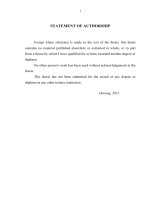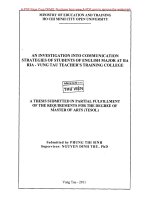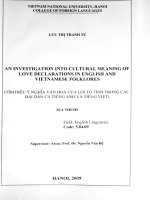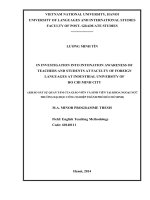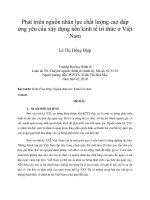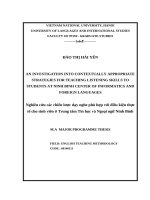An investigation into linguistic features of verbs and their relation to the circumstances in the verbal processes in english and vietnamese (tt)
Bạn đang xem bản rút gọn của tài liệu. Xem và tải ngay bản đầy đủ của tài liệu tại đây (666.38 KB, 21 trang )
THE UNIVERSITY OF DANANG
UNIVERSITY OF FOREIGN LANGUAGE STUDIES
NGUYỄN VŨ HOÀI CÚC
AN INVESTIGATION INTO LINGUISTIC
FEATURES OF VERBS AND THEIR
RELATION TO THE CIRCUMSTANCES IN
THE VERBAL PROCESSES IN ENGLISH AND
VIETNAMESE
Major : ENGLISH LINGUISTICS
Code : 822.02.01
MASTER THESIS IN
FOREIGN LANGUAGES, LITERATURE AND CULTURE
(A SUMMARY)
Da Nang, 2018
This thesis has been completed at
University of Foreign Language Studies, The University of Da Nang
\
Supervisor : Assoc. Prof. Dr. Phan Văn Hòa
Examiner 1: Dr. Trần Quang Hải
Examiner 2: Assoc.Prof.Dr. Trần Văn Phước
The thesis was orally defended at the Examining Committee
Time: 27th October, 2018
Venue: University of Foreign Language Studies – The
University of Da Nang
This thesis is available for the purpose of reference at:
- Library of University of Foreign Language Studies, The
University of Da Nang.
- The Information Resources Center, The University of Da
Nang.
1
CHAPTER ONE
INTRODUCTION
1.1. RATIONALE
Most of the EFL learners have always dreamt of being capable
of writing and speaking appropriately and effectively. The functional
grammar, a grammar model developed by Michael Halliday in the
1960s serves the communicative purpose of EFL students’ learning
the English language and provides the opportunity for EFL students
to recognize the linguistic features of the language, which they need
to learn for success at school. That is because the functional grammar
emphasizes the way spoken and written language operate in different
social situations.
In comparison with traditional grammar, which focuses on the
ways words are organized within sentences and looks at a language
as a set of rules, functional grammar is concerned with the way
language is put together so that meaning is communicated for
particular purposes, and looks at a language as a system of meaning.
The verbs of saying are one of the important issues in
functional grammar theory by Halliday (1985). They belong to the
field of experiential meaning in the clause as representation. These
verbs still contain many interesting and also complex features that
should be investigated although there have been some researches
involved in their grammatical form and lexical meaning. Especially a
comparison between this type of verbs in English and Vietnamese in
terms of linguistic features and sub-classification on semantic and
syntactic bases is still a gap. One more thing about these verbs is that
the relation of them to the manner circumstances in the verbal
process still stimulate for a further study. In practice, learners tend to
2
make some mistakes when using these verbs because there are many
different verbs of saying and each of them has slightly different and
often subtle shade of meaning, this causes some troubles for the
learners.
As a master student of learning English language, I find it is
difficult for Vietnamese learners to accurately use verbs of saying in
speaking and writing English. Meanwhile, not much of research on
verbal process verbs has been done. Therefore, I consider the using of
verbs of saying in English as the appropriate data for doing research.
In this type of text, I will focus on investigating its meaning
and the use of each verb of saying and their circumstances in
appropriate context in the novel English and Vietnamese. The
exploration of the linguistic features of these verbs is expected to
identify the function of the verbs of saying and their linguistic
features in both languages. Through my primary investigation in
these verbs in English and Vietnamese, I also recognize the relation
of these verbs and the manner circumstances which modify them in
the process of saying inspires to study at the same time with the study
of their semantic and syntactic features. For those reasons, I decided
to choose to carry the research with the title: “An investigation into
linguistic features of verbs and their relation to the manner
circumstances in the verbal processes in English and Vietnamese”.
1.2. AIMS AND OBJECTIVES
1.2.1. Aims
This study aims to provide a relatively comprehensive
description and analysis of the semantic and syntactic features of five
typical verb groups and their circumstances in the verbal processes in
English and Vietnamese. This study is expected to make a
3
comparison of linguistic features of these verbs in English and
Vietnamese and their relation to the circumstance; a classification of
these verbs is hoped to do on functional basis.
1.2.2. Objectives
To achieve the aim of the study, the following objectives are
intended
- To explore the semantic and syntactic features of verbs in
the verbal processes in English and Vietnamese
- To investigate the
relation of these verbs to the
circumstances in the verbal processes in English and Vietnamese
- To make suggestion for using verbs for learning and
teaching English
1.3. SCOPE OF THE STUDY
In the scope of this study, the thesis focuses on the semantic
and syntactic features of verbs in the verbal processes in English and
Vietnamese. This thesis limits the verbs of saying in novel “Pride and
Prejudice by Jane Austen” in English as source language and its
Vietnamese translation “Kiêu hãnh và Định kiến by Diệp Minh Tâm.,
novel “Số Đỏ by Vũ Trọng Phụng” as source language and its
English translation “Dumb Luck” by Nguyễn Nguyệt Cầm and Peter
Zinoman. More specifically, in this thesis the writer intend to
investigate on five principal verb groups:
+ Communicating verbs (say, tell, speak, talk and declare)
+ Positive verbs (Flatter, hope, thank, congratulate, praise)
+ Negative verbs (cry, condemn, blame, complain, quarrel)
+ Instructing verbs (explain, describe, instruct, guide, discuss)
+ Information verbs (answer, inform, mention, reply, ask)
4
The relation of them to the manner circumstances in verbal
process is also under this investigation. In this case manner
circumstances comprise of four subcategories: Means, Quality,
Comparison, Degree in English and Vietnamese’s equivalents are in
the scope of the study.
1.4. RESEARCH QUESTIONS
To achieve the aims and objectives mentioned above, the study
seeks the information for the following research questions:
- What are the semantic and syntactic features of verbs in the
verbal processes in English and Vietnamese?
- What are the similarities and differences in the semantic and
syntactic features of verbs in the verbal processes in English and
Vietnamese?
- What are the relations of these verbs to the manner
circumstances in the verbal process in English and Vietnamese?
- What are the similarities and differences between these
verbs in terms of their relations to the manner circumstances in the
verbal process in English and Vietnamese?
1.5. ORGANIZATION OF THE STUDY
This study consists of 5 main chapters as follows:
Chapter 1: “Introduction”, includes the rationale for the
research, aims and objectives, significance, scope, research questions,
and organization of the study.
Chapter 2: “Literature review”, briefly presents the
overview of previous studies to metonymy. The concepts of idealize
semantic and syntactic features will also be included in this chapter.
5
Chapter 3: “Methods and Procedures” consists of research
methods, research procedures, description of samples and data
analysis.
Chapter 4: “Findings and Discussion” describes the data
through the samples of verbs of saying in verbal process in English
and Vietnamese. This chapter presents the similarities as well as
differences in terms of semantic and syntactic features of verbs of
saying.
Chapter
5:
“Conclusion
and
Implications”,
briefly
summarizes the results analyzed in Chapter 4 and also states some
implications for teaching, learning English and some suggestions for
further research.
1.6. SIGNIFICANCE/JUSTIFICATION OF THE STUDY
I would like to get to know more about the semantic and
syntactic features of verbs of saying and their circumstances in
English and its relation in Vietnamese. This study will help learners
of English and Vietnamese have a comprehensive understanding
about the verbs of saying and their circumstances in two languages. It
also helps the learners know the importance of using each kind of
verbs of saying.
6
CHAPTER TWO
LITERATURE REVIEW AND THEORETICAL
BACKGROUND
2.1. THEORETICAL BACKGROUND
2.1.1. An overview of Systemic Functional Grammar (SFG)
2.1.2. The three metafunctions
2.1.2.1. The ideational function
2.1.2.2. The interpersonal function
2.1.2.3. The textual function
2.1.3. Transitivity: The Grammar of Experiential Meaning
2.1.3.1. Process, Participant, and Circumstances
2.1.3.2. Types of process
2.1.3.3. Circumstances
a. Expansion: Enhancing
b. Expansion: Extending
c. Expansion: Elaborating
d. Projection
2.2. LITERATURE REVIEW
It can be clearly seen that the verb plays an important roles in a
sentence in both English and Vietnamese. So far, verbs have been
studied by many researchers and mentioned to linguistic features in
many books.
Halliday (1994) stated that there are three principal types of
processes found in the English clause: Material, Mental, and
Relational. He also discussed the three subsidiary types: Behavioural,
Verbal, and Existential. In Halliday view, verbal processes are the
processes of saying, but “saying” has to be interpreted in a rather
board sense. Therefore, verbal processes might also more
7
appropriately be called “symbolic” processes. In these processes,
there are four participants: Sayer, Receiver, Verbiage and Target.
Phan Văn Hòa in an article published by language (2007)
provided twelve models of verbal verbs, but the article just is focused
on describing conceptions, activities of the verb “Say”, especially
patterns “say” +x and their functional semantics.
Huỳnh Thị Diễm Trinh (2009) examined “The process of
saying in English and Vietnamese: Models of Verbal verb + x”. The
writer pointed out the similarities and differences in semantic features
and relations of the models verbal verb + x.
In addition, some studies are carried out such as “Semantic
features and syntactic relations realized by Say-Tell-Speak-Talk” by
Trần Thị Phước Hạnh (2002) In her research, she distinguished
features of VPVs. Besides, Trần Văn Chương (2011) studied “The
linguistic features of saying verbs used in political documents in
English and Vietnamese”. The author discussed the semantic and
syntactic features of saying verbs, and pointed out the similarities and
differences of these verbs.
Nguyễn Thị Mai Linh (2015) showed the similarities and
differences of verbal processes in the short stories “Runaway” versus
in its Vietnamese translation equivalent “Trốn chạy” in term of
syntactic and semantic.
All of the documents could be applied the referent resources of
this research. Besides, there has been so far no research into the
semantic and syntactic features of verbs and their circumstances in
the verbal processes, so I have decided on this thesis entitled “An
investigation into semantic and syntactic features of verbs and their
relation to the manner circumstances in the verbal processes in
English and Vietnamese”.
8
CHAPTER THREE
RESEARCH DESIGN AND METHODOLOGY
3.1. METHODOLOGY
To meet the demand of objectivity, in this study, descriptive
and contrastive methods are chosen as the dominant ones used in this
paper.
Descriptive method: This method is used in order to describe
and demonstrate the semantic and syntactic features of verbs and
their manner circumstances in the verbal processes.
The contrastive method is used in analyzing data so that the
writer can find out the similarities and differences in analyze the
semantics and syntactic features of verbs and their manner
circumstances in the verbal processes.
3.2. SAMPLING
To serve the study, the number of samples are 1000 in English
and Vietnamese (400 in Vietnamese and 600 in English), collected
from “Pride and Prejudice by Jane Austen” in English as source
language and its Vietnamese translation “Kiêu hãnh và Định kiến by
Diệp Minh Tâm”, the novels “Số Đỏ by Vũ Trọng Phụng” as source
language and its English translation “Dumb Luck” by Nguyễn
Nguyệt Cầm and Peter Zinoman. The samples are selected basing on
the sentences or discourses which contain verbs of saying in the five
groups of verb. Also, in the novel “Số Đỏ” the verbs are chosen if
they have the verbs belonging to the five groups of verb in the
English version. Besides, the selected verbs must be the main verbs
of the sentences or discourses. For example: “I want to say with him”
the verb “say” is not chosen because the main verb of the sentence is
9
“want” not “say”. However, in the example “I say to him” the verb
“say” is selected since it is the main verb of the sentence.
3.3. DATA COLLECTION
First of all, the system of criteria for choosing the sentences
containing verbs of saying and their manner circumstances in the
verbal process is established. The relevant data serving this study are
taken from discourses in the novels, their versions and some from
English and Vietnamese newspapers.
Then, the data are divided into categories depending on their
semantic and syntactic features. From the samples collected, we try
to choose the best and correct ones with cares to illustrate what we
want to mention. To the manner circumstances, the data for them are
also classified into 4 types as announced in 2.2.3.3 above.
3.4. DATA ANALYSIS
The samples of data used in the study are required to be precise
and the collecting procedures must be logical. In this study, the
collected data was analyzed on the basis of linguistic knowledge to
investigate the similar and distinctive features of verbs and their
circumstances in the verbal process used in novel “Pride and
Prejudice by Jane Austen” in English as source language and its
Vietnamese translation “Kiêu hãnh và Định kiến by Diệp Minh
Tâm”, novel “Số Đỏ by Vũ Trọng Phụng” as source language and its
English translation “Dumb Luck” by Nguyễn Nguyệt Cầm and Peter
Zinoman. Therefore, we can draw out the similarities and differences
on the linguistic features. The study strictly follows the research
design, research methodology and research procedures as mentioned
above.
In addition, since the researcher employed theoretical
10
background which based on Halliday’s approach in two versions An
Introduction to Functional Grammar (Halliday, 1994) and An
Introduction to Functional
Grammar
(Halliday, 2004)
this
contributes to the reliability of the research. Moreover, conclusions
were drawn from findings after the careful and accurate process of
data analysis.
CHAPTER FOUR
FINDINGS AND DISCUSSIONS
This chapter presents and discusses the findings form the data
analysis in term of the semantic and syntactic features of verbs and
their relation to manner circumstances in the verbal processes in
English and Vietnamese as well as points out the similarities and
differences of these verbs in these two languages. A description of all
the components of the verbal processes will be given. In addition, the
relation between these verbs and the four main types of manner
circumstances are investigated in order to make clear the
subcategories of circumstances in both languages. Finally, the result
of comparison is used as a foundation for using these verbs for
learning and teaching in the last chapter.
There are so many verbs denoting the verbal process in English
and Vietnamese, so the writer classifies the verbs basing on the
following criteria. First, basing on the pronouncing voice manner, the
writer categorizes the verbs into Communicating verbs. Then, the
Positive and Negative verbs are classified according to their function.
If some verbs direct the writer in how to respond to a question, they
are classified into Instructing verbs. Finally, the verbs are grouped
into Information verbs if the verbs can provide information.
11
Therefore, the classification of verbs may be summarized in the
following table:
Table 4.1. Verbs Denoting Verbal Process
Types
English Saying Verbs
Vietnamese Saying Verbs
Communicating
Say, Tell, Speak, Talk,
Nói, bảo, bày tỏ, nhắn, cho biết, nói
Verbs
Declare
chuyện, trao đổi, tiếp chuyện, tuyên
bố, đáp, kể, bàn, mở miệng
Flatter, Hope, Thank,
Tâng bốc, hi vọng, cảm ơn, chúc
Congratulate, Praise
mừng, ca ngợi
Cry, Condemn, Blame,
Thốt lên, lên án, trách, than phiền,
Complain, Quarrel
tranh cãi
Instructing
Explain, Describe,
Giải thích, mô tả, chỉ dẫn, hướng
Verbs
Instruct, Guide, Discuss
dẫn, bàn luận
Information
Answer, Inform,
Trả lời, cho biết,đề cập, đáp, hỏi
Verbs
Mention, Reply, Ask
Positive Verbs
Negative Verbs
4.1. SEMANTIC FEATURES OF VERBS OF SAYING
In this section, each verb groups will be discussed and
analyzed carefully and compared between the novel “Pride and
Prejudice” by Jane Austen and its Vietnamese translation “Kiêu hãnh
và Định kiến” by Diệp Minh Tâm; and the novel “Số Đỏ” by Vũ
Trọng Phụng and its English translation “Dumb Luck” By Nguyễn
Nguyệt Cầm. English verbs of saying are divided into five different
types:
communicating,
negative,
positive,
instructing
and
information. As George Yule states in Pragmatics [45], semantics
refers to “The study of the relationships between linguistics forms
and entities in the world, that is, how words literally connect to
12
things. Semantic analysis also attempts to establish the relationships
between verbal descriptions and states of affairs in the world as
accurate (true) or regardless of who produces that description.” As
mentioned in Chapter 2, in Verbal process the main participant is the
Sayer by which messages can be represented or conveyed. There are
also three participants involved in the verbal process: the Receiver,
the Target and the Verbiage. In the verbal process, the verbs of
saying can be realized in the following formula:
(1) [SAYER + V]
(2) [SAYER + V + VERBIAGE]
(3) [SAYER + V + RECEIVER]
(4) [SAYER + V + RECEIVER + VERBIAGE]
(5) [SAYER + V + TARGET]
(6) [SAYER + V + TARGET + VERBIAGE]
(7) [SAYER + V + TARGET + RECEIVER]
(8) [SAYER + V + TARGET + RECEIVER]
4.1.1 . Semantic features of Verbs of Communicating
4.1.2 . Semantic features of Positive Verbs
4.1.3 . Semantic features of Negative Verbs
4.1.4 . Semantic features of Instructing Verbs
4.1.5 . Semantic features of Information Verbs
4.2. SYNTACTIC FEATURES OF VERBS OF SAYING
4.2.1. The Syntactic Classification of Verbs
In former traditional grammar books and dictionaries, verbs
are often classified into intransitive Verbs (come, laugh, go, vote,
etc.), which do not take a direct object or follow by an Adverbial
modifier (or Adjunct) and transitive Verbs (answer, get, say, etc.),
13
which often take as its complementation a direct object (and possibly
followed by another element).
- Intransitive verbs:
Verb used alone [ V ]
Verb + adverb or prepositional phrase [V + adv/ prep.]
- Transitive verbs:
Verb + noun phrase [ V. NP ]
Verb + noun phrase + adverb or prepositional phrase [VN
+adv/ prep.]
- Transitive verbs with two objects:
Verb + noun phrase + noun phrase [ V.N.N ]
- Verbs used with clauses or phrases:
Verb + that clause [ V- that ]
Verb + noun phrase + that clause [ VN that]
Verb + Wh-clause [ V wh- ]
Verb + noun phrase + Wh-clause [ VN- wh ]
Verb + To infinitive [V To]
Verb + noun phrase to infinitive [ VN To ]
Verb + ing phrase [V-ing ]
Verb + noun phrase ing phrase [VN -ing ]
This latest contemporary classification of Verbs in accordance
with the possible Verb patterns, to some extent, keeps in close
connection with the conception raised by R.Quirk et al’s ‘A
Grammar of Contemporary English’ (1972) and ‘A Comprehensive
Grammar of the English Language’ (1985), also in S.Greenbaum’s
(1996) ‘The Oxford English Grammar’. In these four English famous
linguists’ works, the general classification of English Verbs and also
14
any other language’s Verbs universally, may be summarized in the
table 4.1:
Table 4.53. Table of classifying of English verbs
Verbs
Intransitive
V + { or V + A (optional)
Monotransitive
V + Od
Complex
Transitive
V + Od + Adj or V + Od + A
Ditransitive
V + Oi + Od
4.2.2. The Syntactic Classification of Verbs of saying in the
novels “Pride and Prejudice ” in English and its Vietnamese
translation “ Kiêu hãnh và Định kiến”, the novels “ Số Đỏ” and
its English translation “ Dumb Luck”
Verbs make up one of the major form classes, comprising
words which express the process. As we mentioned above, there are
different kinds of major processes, namely Material process, Mental
process, Relational process, Verbal process, Behavioural process and
Existential process. In VPs, verbal clauses are divided into
intransitive verbal clauses, monotransitive verbal clauses, ditransitive
verbal clauses and complex transitive verbal clauses. Therefore, some
VPs have only one participant, others have two or even three
participants. VPs are classified into many subtypes, but I would like
to present some main subtypes as follows:
a. Intransitive verbs
b. Monotransitive verbs
c. Ditransitive verbs
d. Verbs used with clauses or phrases
15
4.3. THE SIMILARITIES AND DIFFERENCES IN THE
SEMANTIC AND SYNTACTIC FEATURES OF VERBS IN
THE
VERBAL
PROCESSES
IN
ENGLISH
AND
VIETNAMESE
4.3.1. The similarities in the semantic and syntactic features of
verbs in the verbal processes in English and Vietnamese
4.3.1.1. The similarities in the semantic features of verbs
4.3.1.2. The similarities in the syntactic features of verbs
4.3.2. The differences in the semantic and syntactic features of
verbs in the verbal processes in English and Vietnamese
4.3.2.1. The differences in the semantic features of verbs
4.3.2.2. The differences in the syntactic features of verbs
4.4. THE RELATION OF VERBS OF SAYING TO THE
MANER CIRCUMSTANCES
4.4.1. Manner
4.4.2. The Frequency of Circumstances of Manner
4.5. THE SIMILARITIES AND DIFFERENCES BETWEEN
THESE VERBS IN TERMS OF THEIR REALATIONS TO
THE
MANNER
CIRCUMSTANCES
IN
THE
VERBAL
PROCESS IN ENGLISH AND VIETNAMESE
4.5.1. The similarities between these verbs in terms of their
relations to the Manner circumstances in the verbal process in
English and Vietnamese
4.5.2. The differences between these verbs in terms of their
relations to the Manner circumstances in the verbal process in
English and Vietnamese
16
CHAPTER FIVE
CONCLUSIONS AND IMPLICATIONS
5.1. CONCLUDING REMARKS
In this study, the Verbs of saying (VS) have been analyzed in
syntactic and semantic features in the light of functional grammar.
The interesting characteristics and distinctions of the VS can be
summarized as follows:
Through the whole research, the verbs of saying are classified
into five groups: Communicating verbs, Positive verbs, Negative
verbs, Instructing verbs and Information verbs. Each group of verb
has a distinctive feature and creates different effects on performance
and certain impact on readers. Among these five categories,
Communicating verbs are the most predominant ones, accounting for
over 50% in both Vietnamese and English works.
In the verbal process, the number of participants in both
English and Vietnamese novels is quite equal. However, in some
circumstances, the participants in the original works are more or less
than those in the translational ones. It can be seen that in some
translation clauses some words are added while some are omitted
compared to original clauses.
Some interesting points can also be found in term of the
syntactic features. There is the change of some of existing positions
in the intransitive verbal clauses between English and Vietnamese.
We can see that the Verb or Reporting verb like Said can stand in
front of the Subject in Direct speech in English. However, we cannot
put the Verb in front of the Subject in Vietnamese verbal clauses; the
Verb is usually behind the Subject in the Direct or Indirect speech.
Besides, there is a similar between monotransitive verbal verbs and
17
ditransitive verbal verbs is that they are used the prepositions in
Vietnamese. The prepositions are added into Vietnamsese clause due
to the habit of the Vietnamese people in communication context,
which is aimed at clarifying the meaning of the clauses.
Last but not least, in both English and Vietnamese the four
types of Circumstances are employed in the clauses. This is because
the writer wants to emphasize his/her attitude or feeling of the Sayer.
However, the Manner Circumstances of Quality occurs much more
frequent than the rest three. Also, we can see that most of the
Circumstances are put in front or behind the saying verbs in
Vietnamese and English clauses without changing the meaning of the
Circumstances as well as the clauses. In addition, in some context,
the Circumstances are omitted from the original clause.
5.2. IMPLICATIONS FOR LANGUAGE TEACHING AND
LEARNING
In the four chapters previously mentioned, we have attempted
to give answers to the research questions made about the syntactic
and semantic features of VS in English and Vietnamese. When
dealing with VS, I realize that English language learners normally
have difficulty in grasping the semantic features as well as the
syntactic features of VS in English and Vietnamese to use them
effectively. The findings of the research, therefore, enable us to
explore appropriate suggestions that will help students overcome the
difficulties in their learning.
Firstly, the overview of the processes in the transitivity system
helps the students distinguish between different types of processes
and draw their attention to structural patterns in the clause which may
otherwise be considered by some students as arbitrary rather than
18
being related to meaning and function. In addition to that, to some
students, the structural patterns are considered arbitrary rather than
being related to meaning and function. Therefore, it is important and
useful for teachers to implicate VS and guide the students to make
grammatical analysis when learning grammar.
Secondly, at the more advanced levels of learning, teachers,
students and translators as well, should pay closely attention to cases
of English and Vietnamese translational equivalents and non –
translational equivalents concerning the English and Vietnamese
verbal process verbs.
Thirdly, it is important to emphasize here that the definition of
Verbiage as “what is said” does not mean that it should cover the
quoted and reported speech as it is usually treated in non-systemic
functional grammar. In fact the function of verbiage should not be
identified with the function of the projected clause in a verbal clause
complex. In order to avoid this mistake when dealing with English
VS, learners should be provided not only well-rounded knowledge of
VS in both languages but also opportunities to practice them in
context.
Lastly, the results of the study enable to help English learners
have a comprehensive understanding about the semantic and
syntactic features of VPs in both languages. Therefore the learners
are able to use verbal verbs effectively.
5.3. SUGGESTIONS FOR FURTHER RESEARCH
Within the scope of a master thesis we cannot cover all the
features of VPs in both English and Vietnamese, the study just limits
itself to the syntactic and semantic features of VPs in novel “Pride
and Prejudice by Jane Austen” in English as source language and its
19
Vietnamese translation “Kiêu hãnh và Định kiến by Diệp Minh
Tâm”, novel “Số Đỏ by Vũ Trọng Phụng” as source language and its
English translation “Dumb Luck” by Nguyễn Nguyệt Cầm and Peter
Zinoman. Therefore there are still areas for further studies such as:
An investigation into pragmatic features of Verbs of Saying
in English and Vietnamese.
An investigation of Manner circumstances in English and
Vietnamese.

